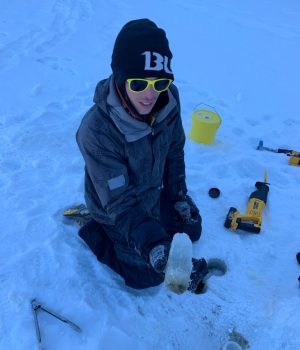Jacob Buffo
Postdoctoral Researcher
Dartmouth College

Overview
My research focuses on the numerical modeling of sea ice, ice shelves, and the icy shells of moons in the solar system and how this impacts their evolution, dynamics, and potential habitability. In particular I am interested in the micro-scale (~1cm) interactions that occur at, and near, the ice-ocean interface of these environments. My work aims to accurately model these small scale interactions by combining numerical simulations that incorporate thermodynamics, chemistry, and equations for reactive fluid and solute transport in porous media, along with laboratory and field observations, to better constrain parameterizations used in large scale models for climate, ocean, atmospheric, Earth systems, and planetary science.
Sea Ice Modeling
YouTube video link here.
Sea Ice
Sea ice is a ubiquitous feature of the polar regions, and as the boundary layer between the atmosphere and ocean it acts as a mediator for thermal and chemical transport, as well as supplies a habitat for a number of microbiota crucial to these area’s ecosystems. Simulating sea ice formation and evolution helps constrain climatic, oceanic, and atmospheric models yet accurate incorporation into Earth systems models is elusive due to the complex nature of the sea ice structure. Sea ice contains a sizable fraction of liquid and air filled pockets and channels throughout its stratigraphy due to the fractional crystallization of sea water, where salt is rejected during its solidification. This leads to multiphase system capable of heat, solute, and mass transfer by diffusive as well as advective processes. This is especially true near the ice-ocean interface where tens of centimeters from the bottom of the ice liquid fraction may remain as high as 10%. My models address these complex physics and include the physics of reactive transport (known as mushy layer theory) needed to describe the system as well as parameterizations for exotic phenomenon such as platelet ice accretion (an inverse sedimentation process that occurs near ice shelves, leading to an upside down ‘snowing’ of ice crystals onto the ice’s basal surface).
Europa
One of four Galilean satellites, Europa is a unique moon thought to harbor a large (~100km thick) subsurface ocean beneath an icy outer shell (~10-30 km thick). The presence of such a large water reservoir has made it a primary target for astrobiological investigations. Additionally, its young and mottled surface indicates the moon is likely host to substantial ongoing geophysical activity. As the barrier and conveyor of chemicals to and from the ocean, the ice shell plays a crucial role in dictating the moons habitability. Moreover, many geophysical processes within the ice shell have been linked to thermochemical heterogeneities in the ice. Currently, however, the chemical inventory and distribution of the ice shell remains relatively unconstrained. In an effort to better constrain the impurity entrainment and distribution of such planetary ices we have adapted our sea ice models to accommodate the environments of these ice-ocean worlds. These techniques provide a method to quantify the chemical and material properties of planetary ices and are broadly applicable to ice-ocean interfaces throughout the solar system. Our hope is to provide consumable and accessible multiphase reactive transport codes that can be easily modified, adapted, and tailored to unique planetary ice-ocean environments for use in geophysical and biogeochemical models of these icy systems.
Field Work in North Central British Columbia
Photos: (Top) Basque Lake (Bottom) Last Chance Lake [Feb. 2019]
As part of the NASA funded Oceans Across Space and Time project, I have carried out field work in the Caribou Plateau of British Columbia looking at the thermochemical evolution and biological entrainment of ices in hypersaline lakes. These planetary analog systems have diverse chemistries that may mimic Martian brines and the ice-ocean/brine interfaces of moons like Europa and Enceladus. By extracting ice samples and measuring an array of properties (temperature, ionic composition via ion chromatography, bioburden via cell counting, and microbial ecology via 16s rRNA) we can better understand how organisms thrive in these super cold and super salty environmental analogs. This provides insight into where and how potential astrobiological organisms may colonize other ice-ocean worlds in the solar system – guiding both planetary exploration and protection. Integrating these measurements with our numerical models can help produce predictive tools to investigate biogeochemical processes in planetary ices.
Papers
Multiphase Reactive Transport and Platelet Ice Accretion in the Sea Ice of McMurdo Sound, Antarctica
Codes
SlushFund2.0-v2 (Interactive Code: Active Interface Tracking and Improved Molecular Diffusion Discretization) – MATLAB Codes
SlushFund2.0 (Active Interface Tracking) – MATLAB Codes
SlushFund1.0 – MATLAB Codes
Liquidus1.0 – MATLAB Codes
Background
I grew up in Shueyville, Iowa and subsequently attended the University of Iowa where I received a double major in Astronomy (B.S.) and Physics (B.S.) as well as a minor in Mathematics. After graduating in December of 2013 I spent a winter as a snowboard instructor in Winter Park, Colorado before coming to Georgia Tech where I am currently a PhD candidate.


